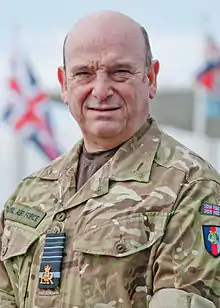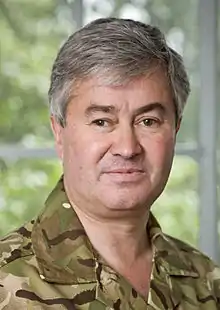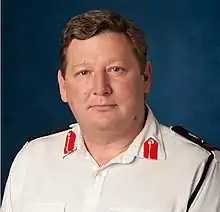Strategic Command (United Kingdom)
The United Kingdom's Strategic Command, previously known as Joint Forces Command (JFC), manages allocated joint capabilities from the three armed services.
| Strategic Command | |
|---|---|
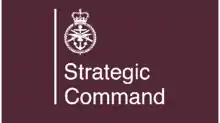 Logo of Strategic Command | |
| Active | April 2012 – December 2019 (as Joint Forces Command) December 2019 – present (as Strategic Command) |
| Country | |
| Branch | |
| Type | Joint Command |
| Part of | Ministry of Defence |
| Headquarters | Northwood Headquarters, Hertfordshire |
| Website | www |
| Commanders | |
| Current commander | General Sir Patrick Sanders |
History
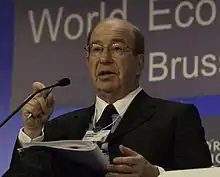
Background
In August 2010 the then Defence Secretary, Liam Fox, asked Lord Levene, a former Chief of Defence Procurement, to chair the Defence Reform Steering Group. The group's remit was to independently review defence and the structure and management of the Ministry of Defence. The group reported in June 2011, with a key recommendation being that a Joint Forces Command (JFC) should be created to manage and deliver specific joint capabilities and to take the lead on joint warfare development, learning from lessons and experimentation to advise on how the military should conduct joint operations in the future. The Defence Reform report also made the following recommendations:[1]
- Joint Forces Command should be led by a military four-star ranking officer who would have responsibility for commanding and generating the joint capabilities allocated to the command and setting the framework for joint enablers that sit in the single services.
- A number of military organisations currently managed centrally within the MOD should pass to Joint Forces Command, including the Directorate Special Forces, the Defence Academy and the Development Concepts and Doctrine Centre.
- The Permanent Joint Headquarters (PJHQ) should sit within the Joint Forces Command, but report for operational purposes direct to the Chief of the Defence Staff.
- In implementing Joint Forces Command, the MOD should review in detail joint or potentially joint capabilities and functions across the armed services (Royal Navy, Army and Royal Air Force), to determine which could be rationalised, the benefit of further joint organisations, which organisations should transfer to Joint Forces Command and which should transfer to a lead service.
Establishment as Joint Forces Command
The creation of Joint Forces Command was overseen by the then Vice Chief of the Defence Staff, General Sir Nicholas Houghton, Air Chief Marshal Sir Stuart Peach, and the Defence Reform Unit, alongside the wider implementation of the new defence operating model identified by the report on Defence Reform. ACM Peach was appointed as the first commander of Joint Forces Command on 15 September 2011, taking up the post on 1 December 2011.[2]
Initial Operating Capability was achieved in April 2012 and Full Operating Capability reached in April 2013, giving JFC a total of some 30,000 military and civil personnel.[3]
Change to Strategic Command
The Secretary of State for Defence, Penny Mordaunt, announced in July 2019 that Joint Forces Command would be renamed as 'Strategic Command', dealing with the Ministry of Defence's transformation programme and taking responsibility for a range of strategic and defence-wide capabilities.[4] Strategic Command will integrate fighting across Air, Land, Sea, Cyber and Space and ensure the armed services operate at the forefront of the information environment.[5]
On 9 December 2019, it was announced that Joint Forces Command was renamed as Strategic Command.[6]
Organisations and components
Strategic Command comprises the following organisations and components.[7][8][9]
The Commander, Strategic Command, based at Northwood Headquarters, brings coherence to the delivery of joint effect by managing, delivering and championing joint capabilities to support success of military operations.[10] He is supported by a deputy commander. Under Deputy Commander comes Chief of Staff, Director Strategy and Director Capability all who are key members of the Command Group.[11][12][9]
Chief of Staff Strategic Command
The Chief of Staff of the Strategic Command Chief of Staff "provides financial authority and supports the command function of Strategic Command headquarters". The Chief of Staff is a member of Strategic Command's Command Group.[13][9]
Permanent Joint Operating Bases
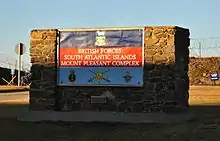
The Permanent Joint Operating Bases provide a defensive and security role to British Overseas Territories and allows the UK to project military power overseas. There is a civilian Director Overseas Bases, appointed in 2018. Director Overseas Bases is a member of Strategic Command's Command Group.[14][9]
Defence Intelligence
The Chief of Defence Intelligence (DI) is the principal adviser on strategic military intelligence issues. DI primarily provides intelligence and advice to inform policy, deployment and research decisions, working alongside other government departments, agencies, allies, the EU and NATO.[15] CDI is supported by a civilian deputy and a Director Cyber Intelligence and Information Integration.[9] The following groups are the main components of DI.
Joint Forces Cyber Group
Originally named the Defence Cyber Operations Group, the Joint Forces Cyber Group (JFCyG) was created in May 2013 and plans and co-ordinates UK cyber warfare operations. It commands Joint Cyber Units at GCHQ Cheltenham and MOD Corsham, the Joint Cyber Unit (Reserve) and Information Assurance Units.[16]
The Joint Cyber Unit (Reserve) was established in response to a growing cyber warfare threat and to allow the military to benefit from the expertise of civilian IT specialists. Capabilities include offensive cyber operations.[17] The following units contribute personnel to the cyber reserve.[18][19][20]
- Royal Navy Reserve - Reserve Cyber Unit
- Royal Auxiliary Air Force - No. 600 (City of London) Squadron
- Royal Auxiliary Air Force - No. 614 (County of Glamorgan) Squadron
- British Army Reserve - Land Information Assurance Group
- British Army Reserve - 254 (SGIS) Signal Squadron
The Joint Forces Intelligence Group
The Joint Forces Intelligence Group (JFIG) coordinates and analyses intelligence, surveillance and reconnaissance from military and public sources. JFIG is based at RAF Wyton in Cambridgeshire, which is also home to the Defence Intelligence Fusion Centre.[21]
In 2012 the group comprised:[22]
- the Defence Geographic Centre (DGC)
- the Defence HUMINT Organisation (DHO)
- the Joint Aeronautical and Geospatial Organisation (JAGO)
- the Defence Geospatial Intelligence Fusion Centre (DGIFC) (formerly the Joint Air Reconnaissance Intelligence Centre)
- the Joint Service Signals Organisation (JSSO)
Joint Intelligence Training Group
The Joint Intelligence Training Group is based at Chicksands in Bedfordshire and provides the British military with intelligence, security, languages and photography training.
Defence Medical Services
The military and civilian medical and dental personnel from all three British military services, are together known as the Defence Medical Services (DMS). The service is commanded by the Director General DMS (DG DMS), formerly the Surgeon General from headquarters at DMS Whittington in Staffordshire. Under DG DMS, comes Director Defence Healthcare, Director Medical Personnel and Training and Defence Medical Director.[23][9]
Directorate of Joint Capability
The Director of Capability is responsible for delivering a joint capability strategy, including in areas such as special forces; military counter-terrorism, explosive ordnance disposal, CBRN and Command, Control, Communications, Computers, Intelligence, Surveillance and Reconnaissance (C4ISR).[8]
Based at RAF Halton in Buckinghamshire, the Joint Information Activities Group (JIAG) is a deployable team of information, media, technical communications and intelligence specialists.[24]
Directorate of Resources and Policy
The Director of Resources and Policy provides top level budgetting, acts as Senior Finance Officer, Senior Policy Advisor and senior civilian workforce advisor for Joint Forces Command, and is personally responsible for the specific delegations from Director General Finance.Director of Resources and Policy is a member of Strategic Command's Command Group.[8][9]
Directorate Defence Logistics and Support
The Chief of Defence Logistics and Support is a three-star or OF-8 officer.[25] He or she oversees various appointments such as Director Defence Support Transformation, Assistant Chief of the Defence Staff (Support Operations) and Director Joint Support.[26][9]
Directorate of Special Forces
The Director Special Forces (DSF) commands the UK Special Forces (UKSF), which are capable of conducting short-notice high-risk operations in challenging environments around the world. The UK's special forces comprise 22 Special Air Service Regiment, the Special Reconnaissance Regiment, 18 Signal Regiment, the Special Boat Service, the Joint Special Forces Aviation Wing and the Special Forces Support Group.[9]
Defence Digital
The MOD's Defence Digital organisation is led by Ministry of Defence chief information officer (CIO) Charles Forte,[27] who is responsible for information strategy and policy across the MOD and also the delivery of information technology systems across the MOD's corporate and military elements.[8] Defence Digital was created in 2019 when Information Systems & Services and a number of organisations were brought together; at that time it had an annual budget of over £2 billion and about 2,400 staff including military, civil servants and contractors.[27][28]Under CIO comes the following: Director Military Digitalisation, Director Digital Enablement, Director Functional Integration, Chief Data Officer, Director Defensive Cyber and Risk, Executive Director Service Delivery and Operations, Director Operations, Director Delivery Intelligence and Expeditionary Service and Director Core Information Services.[9]
Defence Digital activity is largely at MOD Corsham in Wiltshire, and it has a presence at other sites including:
- Blandford Camp, an Army facility in Dorset, home to the Royal Corps of Signals.[29]
- ISS Boddington, a former non-flying RAF station in Gloucestershire.
- RAF Henlow in Bedfordshire, home to parts of Communication and Information Systems Branch and Operations Support Branch.[29]
Joint Force Development
Joint Force Development is led by Director General Joint Force Development. It "plans and develops the current and future Joint Force and leads capability for concepts and doctrine, education and training, Defence-wide exercises, experimentation, analysis and lessons".[9] The following groups are the main components of DI.
Defence Academy of the United Kingdom
Based at MOD Shrivenham in Oxfordshire, the Defence Academy provides higher education for personnel in the British Armed Forces, the Civil Service, other government departments and service personnel from other nations. The Defence Centre of Training Support, originally headquartered at RAF Halton, forms part of the Defence Academy and is responsible for training military instructors and managers, and other aspects of defence training.
Royal College Defence Studies
The Royal College of Defence Studies The Royal College of Defence Studies (RCDS) instructs the most promising senior officers of the British Armed Forces,
Directorate of Joint Warfare
The role of the Director of Joint Warfare is to enable joint forces to operate effectively by defining, measuring and validating the joint force capabilities and formations required to meet current, unexpected and emerging threats. The directorate is responsible for the development and maintenance of air–land and air–maritime integration, and support to associated initiatives.[8]
Standing Joint Force Headquarters
The Standing Joint Force Headquarters (SJFHQ) is a rapidly deployable component. When deployed, SJFHQ is responsible to Chief of Joint Operations through the Chief of Staff (Operations), otherwise the component reports to the Director of Joint Force Development.[9] The Joint Force Headquarters and Joint Force Logistics Component Headquarters come under the command of the SJFHQ Commander and are based at Northwood Headquarters.[30][31]
Development, Concepts and Doctrine Centre
The Development, Concepts and Doctrine Centre (DCDC) is the MOD’s think tank and is responsible for research work in support of joint concepts and doctrine, as well as and those relating to the Royal Navy, Royal Air Force and British Army.
_at_Northwood_MOD_45152477.jpg.webp)
Joint Operations
The Chief of Joint Operations (CJO) provides operational command of UK forces assigned to overseas joint and combined operations and provides politically aware military advice to the MOD in order to achieve UK's strategic objectives on operations.[8] CJO includes the Permanent Joint Headquarters at Northwood Headquarters in Hertfordshire. He is supported by a Chief of Staff (Operations) and a civilian Chief of Staff (Policy and Finance).[9]
Joint Arms Control Implementation Group
The Joint Arms Control Implementation Group (JACIG) is the UK’s arms control verification agency which is based at RAF Henlow in Bedfordshire. JACIG's work is focussed on implementing three main treaties: the Conventional Armed Forces in Europe (CFE) Treaty, the Vienna Document and the Open Skies Treaty.[32]
Joint Counter-Terrorism Training and Advisory Team
The Joint Counter-Terrorism Training and Advisory Team (JCTTAT) is based at Risborough Barracks in Kent.[33]
Commanders
A list of those who have served as Commander Joint Forces Command (retitled Commander of Strategic Command on 9 December 2019):[34]
| No. | Commander | Took office | Left office | Time in office | Defence branch | Ref | |
|---|---|---|---|---|---|---|---|
| 1 | Air Chief Marshal Sir Stuart Peach (born 1956) | December 2011 | April 2013 | 1 year, 4 months | [35] | ||
| 2 | General Sir Richard Barrons (born 1959) | April 2013 | April 2016 | 3 years | [36] | ||
| 3 | General Sir Christopher Deverell | April 2016 | May 2019 | 3 years, 1 month | [37] | ||
| 4 | General Sir Patrick Sanders | May 2019 | Incumbent | 1 year, 8 months | [38] |
References
- "Defence Reform - An independent report into the structure and management of the Ministry of Defence" (PDF). GOV.UK. Ministry of Defence. 27 June 2017. p. 44. Retrieved 3 October 2017.
- "First Commander of Joint Forces Command takes up post". GOV.UK. Ministry of Defence. 1 December 2011. Retrieved 5 November 2017.
- MOD news - Establishment of JFC retrieved 05 Apr 2012
- "Defence Secretary keynote speech at the Air and Space Power Conference 2019". UK Ministry of Defence. London. 18 July 2019. Retrieved 18 July 2019.
- "Defence Secretary outlines future space programme". Royal Air Force. London. 18 July 2019. Retrieved 18 July 2019.
- "Joint Forces Command to Strategic Command, the journey". gov.uk. Strategic Command. 9 December 2019. Retrieved 9 December 2019.
JFC is also being renamed Strategic Command to better reflect the contribution it makes to defence.
- "About us". GOV.UK. Joint Forces Command. Retrieved 2 November 2017.
- "Organogram - Joint Forces Command". data.gov.uk. 30 September 2016. Retrieved 2 November 2017.
- "How Defence Works" (PDF). assets.publishing.service.gov.u. UK Ministry of Defence. 23 September 2020. Retrieved 7 November 2020.
page 32
- "Joint Forces Command". Gov.uk. Retrieved 2 August 2018.
- @ComdJFC_UK (19 November 2019). "Ahead of his start as Deputy Commander JFC, Major General Rob Magowan presented the 'Team of the Year' accolade at this year's Defence Intelligence Awards. Congratulations to all of the award winners. #OneJFC" (Tweet) – via Twitter.
- Mackie, Colin (5 December 2019). "Admirals Current December 2019" (PDF). gulabin.com. Colin Mackie. Retrieved 15 December 2019.
(to be promoted): Lieutenant-General Robert A. Magowan: Deputy Commander, Joint Forces Command, January 2020
- "Strategic Command about us". GOV.UK. Strategic Command UK. 30 September 2020. Retrieved 30 September 2020.
- "Joint Forces Command appoints new Director of Overseas Bases". Joint Forces Command. Northwood. 22 October 2018. Retrieved 23 October 2019.
- "Defence Intelligence". GOV.UK. Retrieved 2 November 2017.
- "Defence Cyber Operations Group: Finance:Written question - 26326". UK Parliament. 11 February 2016. Retrieved 2 November 2017.
- Sabbagh, Dan (25 September 2020). "Britain has offensive cyberwar capability, top general admits". The Guardian. Retrieved 26 September 2020.
- "Reserve Cyber Unit". Royal Navy. Retrieved 3 December 2017.
- "Cyberspace Communication Specialist (formerly ICT Technician)". Royal Air Force Recruitment. Retrieved 3 December 2017.
- "CRHQ (Royal Signals)". The British Army. Retrieved 3 December 2017.
- "Joint Forces Intelligence Group Achieves Full Operating Capability". Royal Air Force. 22 September 2014. Retrieved 2 November 2017.
- "[Withdrawn] Defence Intelligence: roles". GOV.UK. Retrieved 2019-01-05.
- "Defence Medical Services". GOV.UK. Retrieved 2 November 2017.
- "Joint Information Activities Group (JIAG)". GOV.UK. Ministry of Defence. 12 December 2012. Retrieved 2 November 2017.
- "No. 62844". The London Gazette (Supplement). 3 December 2019. p. 21822.
- "Royal Air Force Senior Appointments". raf.mod.uk. Royal Air Force. 21 October 2019. Retrieved 25 December 2019.
Air Commodore R Hill CBE to be promoted Air Vice-Marshal and to be Director Defence Support Transformation with effect from 21 October 2019 in succession to Major General A S J Fay CB
- "Defence Digital". gov.uk. Defence Digital. 23 January 2020. Retrieved 23 January 2020.
Defence Digital brought together and replaced a number of organisations, including Information Systems and Services (ISS) in 2019.
- Qualtrough, Edward (16 December 2019). "Ministry of Defence CIO Charles Forte interview - Digitising Warfare in the Information Age". CIO. Retrieved 5 April 2020.
- "Joint Force Command - ISS - Engineering Operations" (PDF). RAF Henlow. Retrieved 17 October 2017.
- JFCHQ Secretariat Team (17 August 2015). "Freedom of Information request FOI2015/06830" (PDF). GOV.UK. Ministry of Defence. p. 2.
- "Joint Forces Command - Overview for Initial Operating Capability" (PDF). GOV.UK. Ministry of Defence. p. 1. Retrieved 2 November 2017.
- "The Joint Arms Control Implementation Group" (PDF). RAF Henlow. Royal Air Force. Retrieved 2 November 2017.
- Peach, Air Chief Marshal Sir Stuart (2012). "Defence and Intelligence" (PDF). Geospatial World Forum. Joint Forces Command. p. 3. Retrieved 2 November 2017.
- Commander of Strategic Command, UK Government
- RAF Air Rank Appointments List 07/11 retrieved 1 December 2011
- "New senior military officers appointed". Inside Government. 24 January 2013. Retrieved 24 January 2013.
- "The Secretary of State announces new Senior Appointments in the Armed Services". Ministry of Defence. Retrieved 29 January 2016.
- "No. 62635". The London Gazette (Supplement). 7 May 2019. p. 8120.
